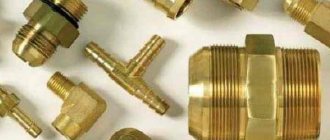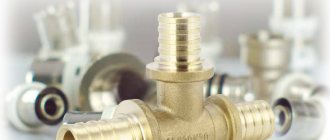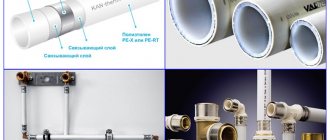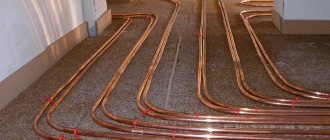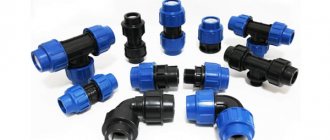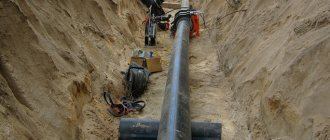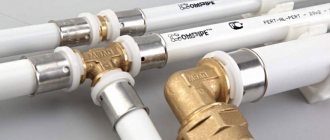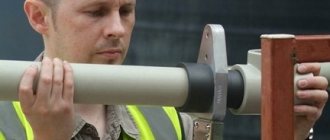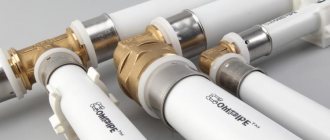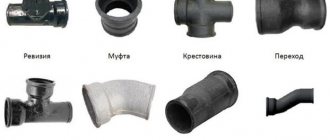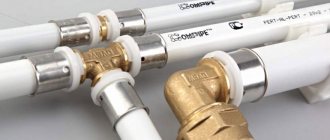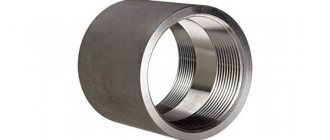These products are not affected by chlorinated water, and this becomes an important factor when choosing them for work.
They are the best option for laying a city water main. After all, copper areas are not affected by corrosion and serve for a long time.
Laying a main line from such pipes is carried out using various connection options. These are: soldering and welding, as well as using fittings for copper pipes for crimping.
Pros and cons of these parts
Connecting pipelines with crimp fittings is very easy. With this method, you do not need to use high temperature or use special equipment.
This is how pipes are laid even in places of difficult access. This work requires the following tools:
- Wrench;
- Calibrator;
- Cutter.
If you compare the time and labor costs for this work, they are small. And the laid pipeline comes out sealed and lasts for a long time.
But, no matter how good such a system is, it still has drawbacks. The crimp fitting must be constantly checked and tightened. For this reason, they are not recommended to be laid under concrete.
And these parts are also designed to operate the system with low pressure. If we compare their reliability with soldering, then these fittings have less reliability.
The connection, mounted with compression fittings, becomes a structure that is used repeatedly.
It can be assembled and disassembled. But, each subsequent installation and dismantling will affect its strength.
Metal-plastic
How are compression fittings for metal-plastic pipes arranged?
The photo shows a corner for mounting a wall-mounted mixer.
The pipe differs from most alternative solutions in its low ring rigidity. This property is compensated by a fitting, which is used as a mandrel: a split ring compresses the edge of the metal-polymer pipeline on its surface.
Additionally seal the connection:
- PTFE washer between the end of the pipe and the fitting support platform. When tightening the nut, the end is pressed against it by a tightening split ring.
- A pair of O-rings placed on the fitting in grooves machined into its surface.
How are compression fittings mounted on metal-plastic pipes?
- The pipe is trimmed with a knife for cutting metal-plastic.
However: the author gets by just fine with a grinder and a metal cutting wheel. The main thing is to make a cut strictly perpendicular to the longitudinal axis.
- It can be calibrated with any object of the appropriate diameter. The goal is to eliminate ovality near the end.
- The chamfer is removed from the inside. This simple measure will help prevent the rubber O-rings from jamming.
- A union nut and a split ring are pressed onto the pipe, after which it is put on the fitting. Rubber rings can be pre-lubricated with liquid soap. The main thing is not to tear them or move them towards the puck.
- The split ring is shifted towards the end, after which the union nut is tightened - manually, then with a pair of wrenches.
How a crimp fitting works and works
This device includes:
- Frame;
- Compression nut;
- Crimping ring. Often one or two rings are placed. They increase the tightness of the joint and provide resistance to high pressures. This also extends the life of the structure.
IMPORTANT! It is recommended to purchase parts in which the seal is not simple rubber, but EPD M. Such products will last longer.
To produce these elements the following is used:
- Brass;
- Copper;
- Plastic;
- Metal.
For copper pipe products, brass fittings are most often used. They are easy to process and have a low cost when compared to copper products.
And the strength of brass is equal to stainless steel, and it fits much easier. To increase the stability of brass fittings, they are plated with nickel.
When purchasing such parts, you need to take into account their weight (do not take light items). Experts also recommend purchasing them from a reputable manufacturer.
This way, finances will not be wasted, and the highway will operate smoothly and reliably.
Copper solder coupling
Corrosion of plumbing fixtures can be a serious problem, potentially costing expensive repairs or replacement parts.
Brass and copper solder couplings allow water, heat and salty fluid to flow without damaging the pipes. Additional equipment works perfectly with brass pipeline fittings. With such uses, fittings and copper adapters are important parts for many plumbing items. You can also buy and install plastic products, the price of which is lower than metal ones, but the performance of the pipeline will be lower.
Types of crimp fittings
Video
Copper fittings
These devices come in the following types:
- Tee. For installation of branches in one direction;
- Cross. For a branch device in two directions;
- Clutch. Used to connect pipe blanks that have the same diameters;
- Retraction. Apply to create a turn;
- Stub. Placed on the end of the cut piece.
For the joint of pipes that have the same diameters, straight parts are used, and for different diameters a transitional option is used.
By type they are divided into:
- Threaded;
- Compression;
- Capillary;
- Press fittings;
- Self-locking.
Threaded elements
They are simple and durable, their design does not require modification. The best option for these parts are brass fittings. They are characterized by increased resistance to corrosion, and are installed in those places of the pipeline where fixation to the wall is required.
IMPORTANT! It is not recommended to combine such fittings with pipelines made of plastic, metal-plastic and copper. Because during twisting, this part can easily crush the workpiece made from the specified materials.
Compression
Situations arise when it is not possible to use open fire, then compression fittings are installed on copper pipelines. They allow you to easily work with workpieces of unequal diameters, and the material may be different.
They come from:
- brass;
- copper;
- metal-plastic;
- plastic;
- become.
They have a crimp ring; it secures the part to the pipe and creates a fairly airtight joint. This ring is tightened manually using a wrench and a connection nut.
IMPORTANT! It is very convenient to work with these elements in areas with difficult access.
Copper
How copper pipes are connected with compression fittings depends on the type of fittings.
Soft seal
Coupling with soft seal.
In this case, the tightness is ensured by the expansion of the rubber or silicone O-ring, which is clamped between the fitting body and the spacer ring when the nut is tightened. The method of assembling the connection is, in general, quite obvious.
The following are placed alternately on a tube of the appropriate diameter:
- Union nut.
- Retaining ring.
- Seal.
Then the tube is inserted into the fitting body, after which the union nut is tightened - first by hand, then 1-2 turns using a pair of adjustable or open-end wrenches. One fixes the position of the body, the second rotates the union nut.
The advantages of this connection scheme are obvious: it does not require trimming or calibrating the edge of the pipe and can be done with your own hands using the simplest tool.
The price of ease of installation is rather moderate reliability: under significant mechanical loads, it is quite possible to tear the pipe out of the connection. Where do the loads come from? Offhand - at least during the water hammer that accompanies the water supply; however, the games of active-aged children are at least no less destructive to plumbing.
Socket connection
Coupling with socket seal.
The second connection scheme is designed for annealed copper and uses its ductility, its ability to deform under load. The tightness is ensured by a cone expanding the end of the pipe, to which it is attracted by a union nut and an o-ring. The connection is stronger and, importantly, more durable: it will maintain tightness even during prolonged severe overheating, which is detrimental to rubber.
The instructions for assembling the connection in this case are noticeably more complicated.
- The pipe is trimmed with a special knife . The end must be strictly perpendicular to its axis.
- Then the union nut and o-ring are pressed onto it.
- The edge is flared so that the cone seal fits inside, after which it is attracted by the union nut and o-ring to the fitting body.
- The hand-tightened nut is tightened with a pair of wrenches . Do not overdo it with force: it is quite easy to break the threads on the brass fitting and break the union nut.
Capillary connection elements
They are more suitable than others for pipe products made of copper and steel. On the inside, under the cut thread, they have a very thin wire made of copper, tin, or silver. This wire becomes the solder.
Video
Pressing copper pipes. Water, gas.
The workpiece, which is coated with flux, is inserted into the fitting. The joint is heated with a burner. Heating is carried out until the molten solder fills the space.
After this, the joint is left to cool. After some time, the joint area is cleaned with special cleaning agents for working with copper.
The described connection is considered the most reliable, and for copper products it is better suited than others.
Problems
Of course, it couldn’t have happened without them. Let us list the most common problems with compression joints.
| Description | Cause | Elimination |
| Leakage on metal-plastic during cyclic heating. | The rubber rings were displaced during installation. Cyclic heating led to deformation of the polyethylene on the fitting that ensured the tightness. | The connection is completely disassembled and reassembled with the correct installation of the O-rings. |
| A leak in a fitting for pipes with any type of soft seal. | The seal has partially lost its elasticity. | Replacing the O-ring. |
| Leak at the flared connection of copper pipes. | Crack in the tube fitted to the cone seal. | The tube is cut off, re-trimmed and flared. |
Leaking from under the nut on hot water is a common problem with compression joints on metal-plastic.
Self-locking connectors
Video
Copper pipe rolling
Self-locking elements are mechanical type devices. It is based on inner rings, and one of these rings has teeth. When pressed with a puller key, they fit tightly into the other ring.
This type of joint is reliable and durable. This part can be used more than once, because with the help of a puller key, it is very easily removed.
This type of fitting is made from copper, and it perfectly holds workpieces of any type of cross-section and different materials together. This is a very convenient way for a pipeline made of various pipe products and fittings.
Steel
Compression fittings for steel pipes - conventional, black and galvanized steel, and made of corrugated stainless steel - are designed almost the same. Actually, their design exactly repeats the devices we have already studied for connecting solid copper: the same union nuts, retaining rings and O-rings.
Compression adapter from a pipe with a diameter of 1/2 inch to a pipe thread of the same diameter.
A device similar in functionality to corrugated stainless steel.
How to install such a connection in the case of a black steel pipe?
- The surface of the pipe is thoroughly cleaned from layers of paint and rust. The work is easy to do with a sharp knife.
- If there is ovality, it is eliminated. With some skill, you can use a regular gas wrench for this purpose.
Please note: it may leave deep scratches on the surface, which is unacceptable. If this happens, take the time to remove the jams with a file.
- Sequentially fit the union nut, split ring and seal onto the end of the pipe.
- Insert the resulting structure into the body and tighten the nut with a pair of wrenches.
In the case of corrugated stainless steel, of course, the first two points can be omitted.
How to install crimp fittings on a copper pipe
Video
Radial presses for crimping fittings
It should be noted right away that this type of connection does not require special equipment, and you can make it yourself.
According to European standards, crimp connectors are divided into two types and are marked with the letter A or B.
Type A. Used exclusively for laying above-ground pipeline networks made from semi-solid copper or stainless steel.
Type B. It is used for above-ground and underground communication systems, created from soft and semi-hard types of copper with thick-walled pipes.
IMPORTANT! To get a very reliable joint, you must act strictly according to certain rules and instructions.
How to install fittings for type A crimp:
Video
Pressing copper pipes is quick and easy! (4)
- An element of the required size is selected. This is easy to do because all connecting structures are produced according to the same European standard;
- A pipe blank of the required size is cut and the burrs are removed. The sections are checked with a gauge. Contamination is removed from the workpiece, poorly processed edges and damage are cleaned. A crimp ring is placed on the workpiece.
ADVICE. It is recommended to wet the joint with water, this will prevent the seal from slipping and breaking;
- The end of the pipe is inserted into the connector until it stops. After this, the clamping nut is tightened. First they twist it by hand, and then take a wrench.
ADVICE. There is no need to apply excessive force during these actions. This will not improve the tightness of the connection. If cheap parts are used for work, then there is a risk of extruding the ring, and then the joint will not be reliable.
After such work, the pipe may be slightly deformed. This will confirm that the connection is made airtight.
How to install type B compression fittings
Video
Copper pipes (installation, soldering)
This type of crimp connection elements is mounted in almost the same way as in the first case. The cutting area is thoroughly cleaned of dirt. The thread should also be free of dirt. Only light lubrication of the threads with machine oil is allowed.
This will make it easier to wrap the pipe. It is necessary to ensure that the seal cone is pressed against the inside of the workpiece, and the edge of the workpiece itself must be flared.
You need to choose the right key. It should not become loose; this will damage the nut. For example, for a diameter of 54 mm, you will need a 750 mm wrench.
Features of connecting these fittings to pipes
Video
The cost of a line made of copper pipes is high, so when purchasing materials it is advised to follow the following rules:
- It is necessary to give preference to homogeneous materials, so the entire structure will last longer;
- Do not combine copper and unalloyed steel. Electrochemical processes between them have a detrimental effect on the connection. In this case, the steel elements become covered with rust;
- If it is impossible to do without using dissimilar materials, then steel products are mounted in front of copper ones in the direction of fluid movement;
- Copper pipes go well with their PVC network elements. There are no negative consequences in this situation.
Application
- High pressure hydraulic circuits.
- Connection of hydraulic pumps, valves and quick tool change.
- Test stands.
- Steel industry.
- Plumbing.
The online store aholod.ru exports various copper adapter couplings for soldering, which can be purchased and delivered in Moscow. The parts are manufactured using optimum quality of raw material. We offer copper couplings, double-socket and single-socket, threaded, in various sizes and shapes that are suitable for any pipe system. Excellent performance characteristics allow the couplings to be used for copper cables in gas and water systems.
The online store offers a wide range of necessary equipment for installation. From us you can purchase copper crimps and couplings, buy pipes, select fittings, angles and much more.
